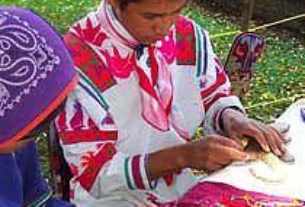Angela Peralta is a big name in Mazatlán (mah-saht-LAHN). And practically everyone, especially the locals, are happy to tell you “the real story” about this legendary, Mexican diva. Only every story you hear is different. So after a lot of research, here’s the authentic saga of Angela Peralta. So they say: When Angela Peralta, lovingly called “The Mexican Nightingale,” arrived in the Port of Mazatlán in 1843, a throng of her adoring fans literally carried her to her hotel, the Iturbide, on the Plaza Machado in “Old Mazatlán.” Just next door was the ornate Rubio Opera House where she was scheduled to perform later in the week.
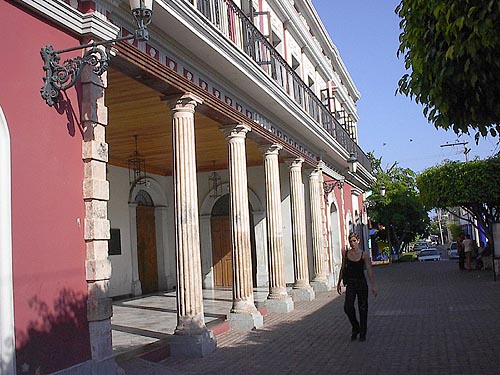
Although weary from her voyage, Peralta stepped out on the balcony of her room (number 10) and serenaded her admirers with arias from her dazzling repertoire. ¡Que Lastima! (what a pity!). The diva was stricken with yellow fever and died soon after, never to perform at the Rubio; her glorious voice stilled forever. Later on, the opera house was converted to a cinema, then a vaudeville stage, a boxing ring, winding up as a parking garage.
In 1975, a hurricane hit Mazatlán with such force that the inside of the theater was left in ruins. But in 1987, a timetable was set in place for a complete restoration, and in 1992, the opera house was re-opened and renamed the Teatro Angela Peralta in her memory. The Iturbide Hotel is now a school of music. Room number 10 doesn’t exist any more. It would be fanciful to think that the ghost of Angela Peralta haunts the site of the old hotel and the opera house. ¡Quien sabe! No one knows for sure.
But everyone agrees, there’s a haunting quality about Mazatlán that grabs you the minute you arrive. Maybe it’s the long afternoon shadow a lone umbrella casts on a deserted beach. Perhaps it’s a beguiling sunset peeking through the wrought iron railing of your hotel balcony. It could be the flashing eyes and the open smiles of locals hawking their wares in one of city’s markets. Maybe all of the above. And then some.
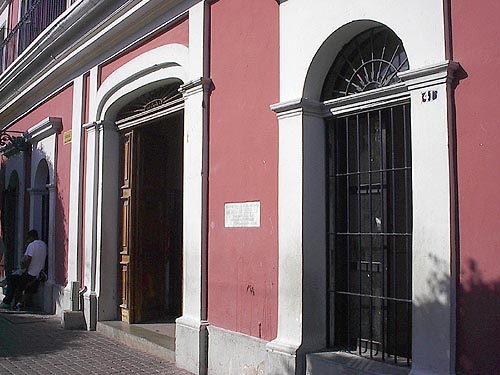
Although Mazatlán definitely is a kinder, gentler place than some other resorts that colorfully dot the coastline of Mexico (more than a million tourists visit here every year), there is a certain amount of glitz that’s inescapable, particularly in the Zona Dorada, the beach-front “gold zone” which is chock-a-block with major tourist hotels, discos and restaurants, each busily bent on seizing a sizeable chunk of the tourism pie. Nice that visitors can get two resorts in one, though, the hectic, jumping pace of the gold zone as well as the quieter, laid-back joys of Old Mazatlán -with the palm-lined malecón, the longest beachfront walkway in Mexico, separating the two. But linger a bit in Old Mazatlán. This is where tourists stayed, long before the now trendy Zona Dorada was “in,” when Cancun and lxtapa were nothing more than isolated sandbars. Stroll the quiet streets (many buildings, now restored, date back to the 18th century).
Take in some of the older hotels, like the Belmar, where well-heeled tourists used to play in the sun. Visit the Teatro Angela Peralta for a concert, opera or play. Stop at the Cathedral opposite the old zocalo. Dine at Pedro and Lola, which bills itself as a “restaurant, bar and bistro.” Diagonally across from the opera house, this popular eatery is dedicated to two of Mexico’s all-time stars, Mazatlán-born Pedro Infante, the movie heartthrob who, although he’s been dead for over 40 years, is very deeply woven into the fabric and life of Mazatlán, and Lola Beltran (“La Grande),” the Sinaloa-born, world-famous mariachi songstress whose records have sold in the millions. They serve up some very zesty fare, including the “Pedro Infante,” the movie star’s favorite pork dish as it was prepared in his home. Also try one of Ms. Beltran’s original recipes. Just ask for the “Lola La Grande.” Anything they offer with shrimp as the main ingredient is a winner.
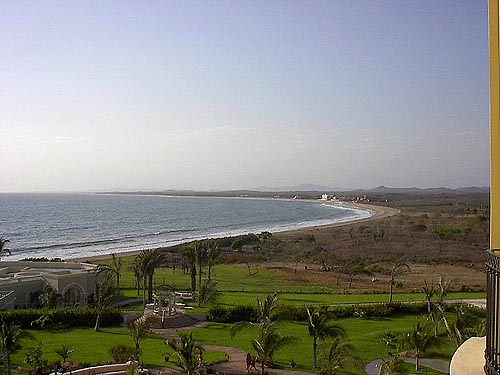
Located in the state of Sinaloa, on a peninsula 740 miles from the Arizona border, Mazatlán is Mexico’s second largest coastal city (Acapulco is number one.) Once the home of the Totorames Indians, its name means “land of deer” in Nahuatl, the ancient language of the Aztecs. “Old Mazatlán,” the original settlement and port area, is still the civic, religious and commercial center of the town. Located on the southern tip of the peninsula, with the Pacific on the west and the Bahía Dársena on the east. Mazatlán has the largest port facility between Los Angeles and the Panama Canal, and is home to Latin America’s largest fleet of commercial shrimp vessels (over 500 boats).
The Spaniards founded Mazatlán in 1531 as a launching point for gold-laden galleons. They hadn’t a clue as to the vast wealth this outpost would one day produce on its own. As the shrimp capital of the world, nearly 40 thousand tons of shrimp are processed here each year. In fact, revenues from commercial fishing are so high, if all the tourists stayed home – which will never happen – Mazatlán’s economy would still thrive. Around 600,000 people call Mazatlán home. Located off of the Pacific Coast just below the Tropic of Cancer, this is where the Mexican tropics begin. Note: Tourism officials say that Mazatlán has probably made more Americans and Canadians aware of Mexico than any other south-of-the-border resort.
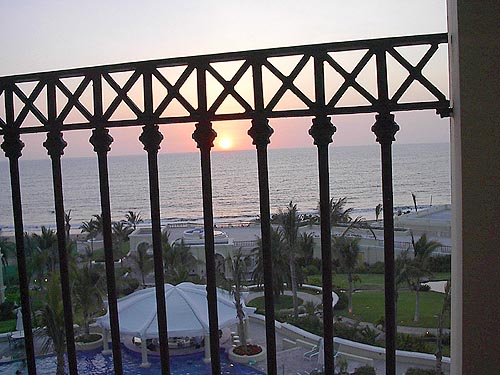
A big draw for tourists, especially sun worshipers, is Mazatlán’s fifteen-mile stretch of beach, the longest in all of Mexico. Some of the most popular (and more crowded) beaches are Playa Los Sabalos and Playa Las Gaviotas. But there are quieter beaches, too, (Playa Las Brujas and Playa Los Cerritos) north of “the zone.” With an average temperature of 80 degrees, Mazatlán lives up to its reputation as the “Pearl of the Pacific.” Tourism is Mazatlán’s second largest industry. Fishing is number one. Striped marlin in the winter; swordfish in the spring; sailfish in the spring and early summer; and tuna year-round.
Records show that proud anglers have pulled a whopping 900-pound black marlin and a 203-pound sailfish from Mazatlán’s waters.
WHAT TO SEE IN MAZATLAN
Mazatlán has its own version of Acapulco’s famous La Quebrada, with divers plunging (from the Cerro de la Nevería) into 45 feet of rocky turbulent water. During high season and on weekends, these stalwart divers perform at around 10:00 am and again at 4:00 pm.
The zócalo (also called the Plaza Revolucíon), has a most unusual gazebo. A hodge-podge of styles and motifs, it’s a 50’s diner look-alike, complete with a vintage juke box, serving hot dogs, burgers and French fries. Maybe even a northern style burrito. There’s also a bandstand.
La Gruta de Cerro del Crestón, directly beneath the El Faro (lighthouse), just between the ocean and the harbor, is a cave that was supposed to be a pirate treasure trove. Whatever! It’s part of the lore of Mazatlán.
The 19th century Cathedral (made a basilica in 1935), is opposite the zócalo. With blue and gold spires, which can be seen from vantage points everywhere in the city, the cathedral’s gilded, ornate altar is dominated with overhead murals of angels.
Just west of downtown is an old Spanish fort, Fuerte Carranza, where Mazatlán defended itself from French invaders in the 1860’s. The view from the fort is the only place where you can see the three islands located off the coast at the same time.
Along the malecon are a few monuments well worth seeing: The Monumento al Pescador (Fisherman’s Monument) is at the entrance to the old port of Mazatlán. Another is a tribute to the beautiful women of Mazatlán, El Monumento a la Mujer Mazatleca. The third, El Monumento al Venado recalls Mazatlán’s Indian heritage. Another landmark is the monument to the deer (symbol of the city).
Because the city is so spread out, a harbor cruise is a good way to get an idea of what Mazatlán is all about. Especially if time is a problem. Stops include the downtown market and Old Mazatlàn.
Shopping, of course, is another thing to do, and for some shopping addicts, the “only” thing to do. Most shops (there are over 120 shops in the gold zone), which carry anything from crafts to resort wear, are open daily from 9:00 am till 8:00 pm (with no siesta). The Mazatlán Arts & Crafts Center, at the northern end of the “zone,” with a colorful array of outlets, many with on-site artisan’s studios, is an excellent place to start. Souvenir shoppers can find their Mazatlán kitsch at the Mercado Viejo Mazatlán and the Tequila Tree, among other places. The lively Central Market sells everything from souvenirs to food.
GETTING AROUND MAZATLAN
The best way to get around this city/resort is by foot. So it’s important to remember to bring good walking shoes. Better still, wait till you get here and pick up a pair or two – they’re sold everywhere at prices way below north-of-the-border malls. There are, of course, taxis, even the low-budget “eco-taxis,” which are plentiful, but not as reliable, also the four-person open-air taxis that are a combination carriage and golf cart. No matter what transportation you use, the advice is to settle on the fare before you hop on. Mopeds are also available for rental. Your best bet is to ride the public buses that operate from the Zona Dorada all the way to Old Mazatlán. Hours of operation are from 7am to 10pm. Saves a lot of footwear and the ride is quite scenic – and cheap.
At the airport, there are mini buses you can take to the hotel zone (10 miles away). Cost is about $4.00 (U.S.) per person. All major car rental companies are at the airport as well.
WHERE TO STAY
At latest count (year-end 2000), there are approximately 7,600 three and four star units in Mazatlán, many in the newly developed area of Emerald Bay, also known as Nuevo Mazatlán. The 78-suite (when completed there’ll be 258 suites) Pueblo Bonito Emerald Bay, which opened in December, 2000, is an example. Just a 12-minute ride from the “zone,” via taxi or complimentary shuttle bus, the 20-acre property has a super beach all to itself.
BEST TIME TO VISIT
Visitors who come to Mazatlán during the four days before Lent (usually February) get to celebrate Carnaval, the third-largest pre Lenten festival in the world (first is Rio; second is New Orleans). Festivities include colorful parades, fireworks, musical events, street parties and gastronomic displays. It’s one of the biggest fiestas in Mexico.
Another good time to come is during November and December when Mazatlán hosts a Cultural Festival, with ballet, opera, music and other theatrical events. The Teatro Angela Peralta is used as the primary venue.

